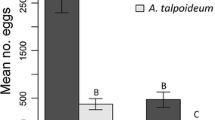Abstract
Chaoborus, the phantom midge (Insecta, Diptera, Chaoboridae), has a widespread distribution, commonly occurring in lakes and ponds all over the world. In the great lakes region of East Africa Chaoborus is present in Lakes Victoria, Albert, Edward, Malawi and George, but absent from Lakes Tanganyika, Kivu and Turkana. Tropical lakes typically have water temperatures in the range of 22–26 °C year round. Lakes Tanganyika and Kivu have only 20% of their bottom sediments oxygenated during full circulation, contrary to 95–100% in all of the other lakes, excluding Lake Malawi (45%) (Hecky & Kling, 1987). Planktivorous fish are present in all lakes (Lehman, 1995). We hypothesized that the absence of Chaoborus larvae from some lakes of East Africa may be the result of interaction among high temperatures, low oxygen levels, and fish predation.
We developed a model to estimate energetic costs for Chaoborus larvae at temperatures greater than 14 °C. We hoped to shed light on the bioenergetics of Chaoborus populations, and the possibility that extant distributions of Chaoborus larvae are the result of energetic constraints.
We found that relative respiratory and growth costs of Chaoborus larvae are highest in the early stages of development. We estimated that non-feeding instar I larvae living in 25 °C water will starve to death in less than one day. It is possible that Chaoborus populations are prevented from establishing in certain areas because high energetic costs condemn young larvae to death by either predation or starvation.
Similar content being viewed by others
References
Berg, K. & P. M. Jonasson, 1965. Oxygen consumption of profundal lake animals at low oxygen content of the water. Hydrobiologia 26: 131–143.
Downing, J. A. & F. H. Rigler, 1984. A manual for the assessment of secondary productivity in fresh waters. Blackwell Scientific Publications, Boston.
Eccles, D. H., 1985. Lake flies and sardines — a cautionary note. Biol. Conserv. 33: 309–333.
Giguere, L. A., 1981. Food assimilation efficiency as a function of temperature and meal sizes in larvae of Chaoborus trivittatus (Diptera: Chaoboridae). J. Anim. Ecol. 50: 103–109.
Gliwicz, Z. M., 1985. Predation or food limitation: an ultimate reason for extinction of planktonic cladoceran species. Arch. Hydrobiol. 21: 419–430.
Hecky, R. E. & H. J. Kling, 1987. Phytoplankton ecology of the great lakes in the rift valley of Central Africa. Arch. Hyrobiol. Beih. Ergebn. Limnol. 25: 197–228.
Larow, E., 1970. The effect of oxygen tension on the vertical migration of Chaoborus larvae. Limnol. Oceanogr. 15: 357–362.
Lehman, J. T., 1995. Pelagic food webs of the East African Great Lakes In T. C. Johnson & E. Odata (eds), Limnology, Climatology, and Paleolimnology of the East African Lakes. Jing, Uganda.
Lewis, W. M., 1975. Distribution and feeding habits of a tropical Chaoborus population. Verh. Int. Ver. Limnol. 19: 3106–3119.
MacDonald, W. W., 1956. Observations on the biology and behavior of chaoborids and chironomids in Lake Victoria and on the feeding habits of the ‘elephant-snout’ fish (Morymyrus kannume Forsk). J. Anim. Ecol. 25: 36–53.
McGowan, L. M., 1974. Ecological studies on Chaoborus (Diptera, Chaoboridae) in Lake George, Uganda. Freshwat. Biol. 4: 483–505.
Northcote, T. G., C. J. Walters & J. M. B. Hume, 1978. Initial impacts of experimental fish introductions on the macrozooplankton of small oligotrophic lakes. Verh. Int. Ver. Limnol. 20: 2003–2012.
Peters, R. H., 1983. The ecological impacts of body size. Cambridge University Press, New York.
Pope, G. f., J. C. H. Carter & G. Power, 1973. The influence of fish on the distribution of Chaoborus spp. (Diptera) and density of larvae in the Matamek River system, Quebec. Trans. Am. Fish. Soc. 102: 707–714.
Ratte, H. T., 1984. Temperature and Insect Development. In K. H. Hoffman (ed.), Environmental Physiology and Biochemistry of Insects. Springer Verlag, Berlin.
Stahl, J. B., 1966. The ecology of Chaoborus in Myers Lake, Indiana. Limnol. Oceanogr. 11: 177–183.
Swift, M. C., 1976. Energetics of vertical migration in Chaoborus trivittatus larvae. Ecology 57: 900–914.
Thornhill, R. & J. Alcock, 1983. Evolution of Insect Mating Systems. Harvard University Press, Cambridge, Mass.
Author information
Authors and Affiliations
Rights and permissions
About this article
Cite this article
Halat, K.M., Lehman, J.T. Temperature-dependent energetics of Chaoborus populations: hypothesis for anomalous distributions in the great lakes of East Africa. Hydrobiologia 330, 31–36 (1996). https://doi.org/10.1007/BF00020820
Received:
Revised:
Accepted:
Issue Date:
DOI: https://doi.org/10.1007/BF00020820




